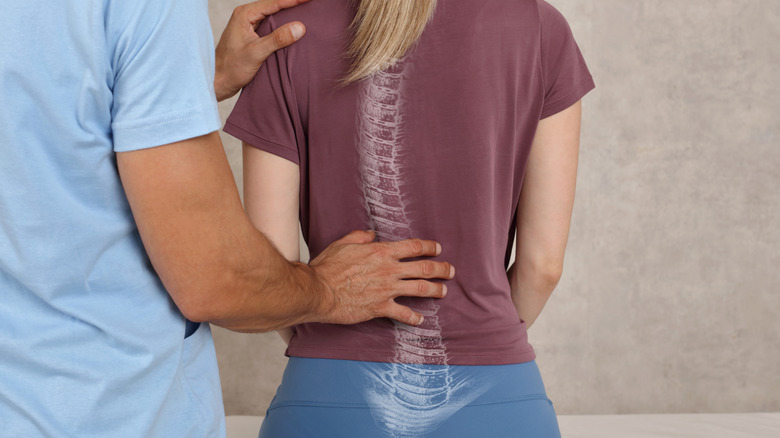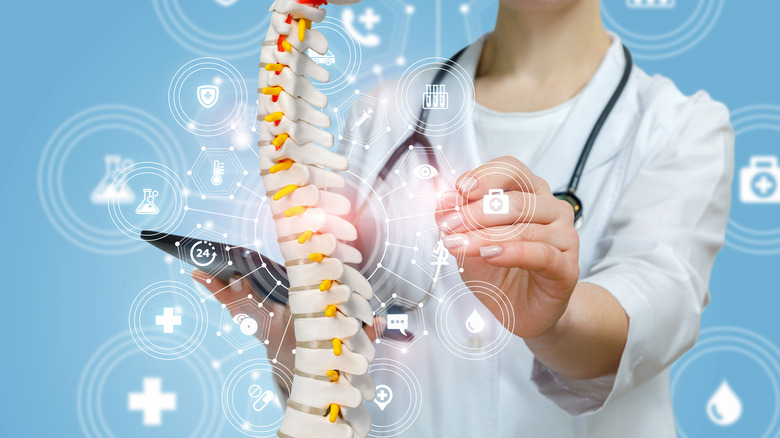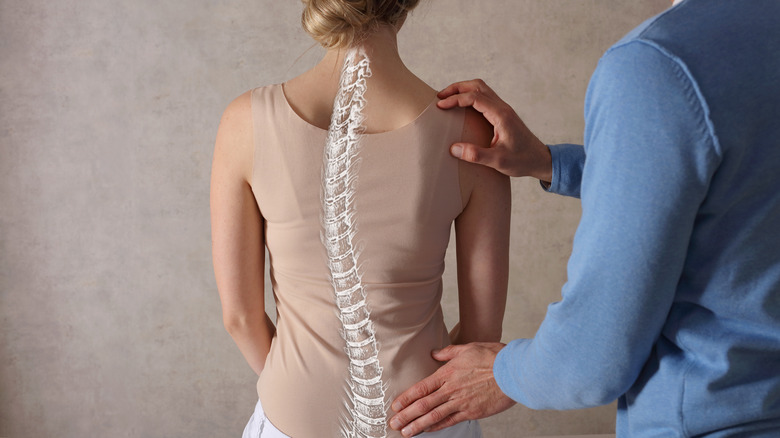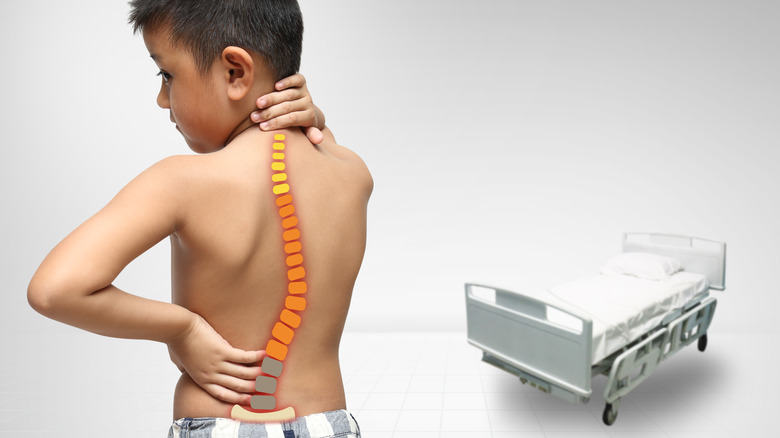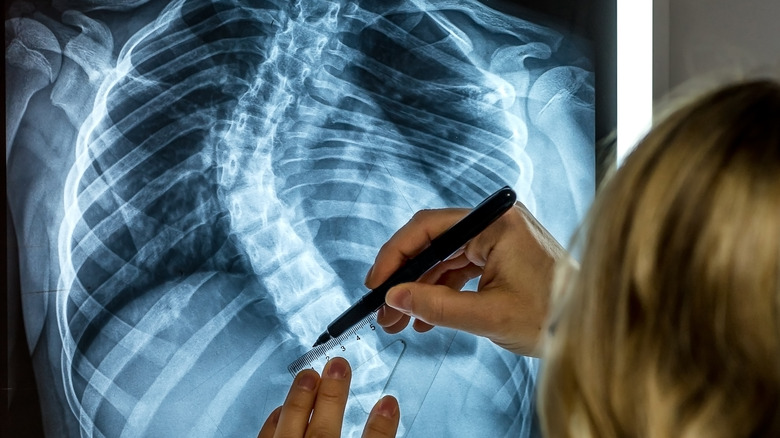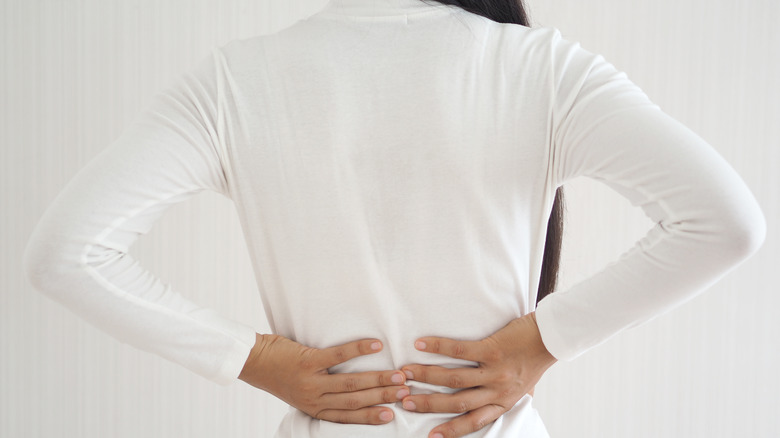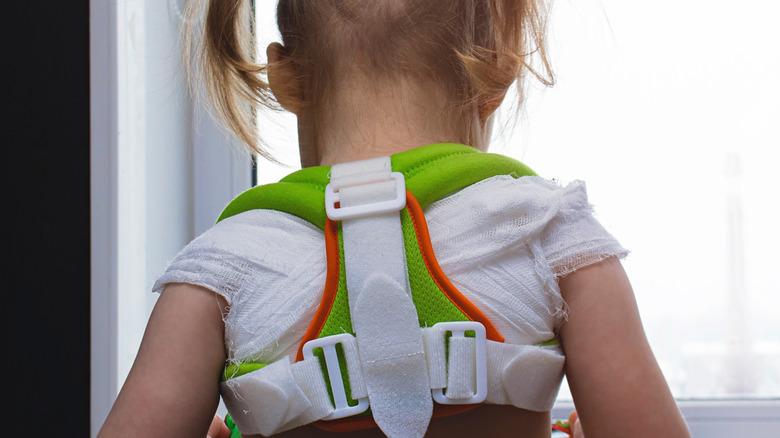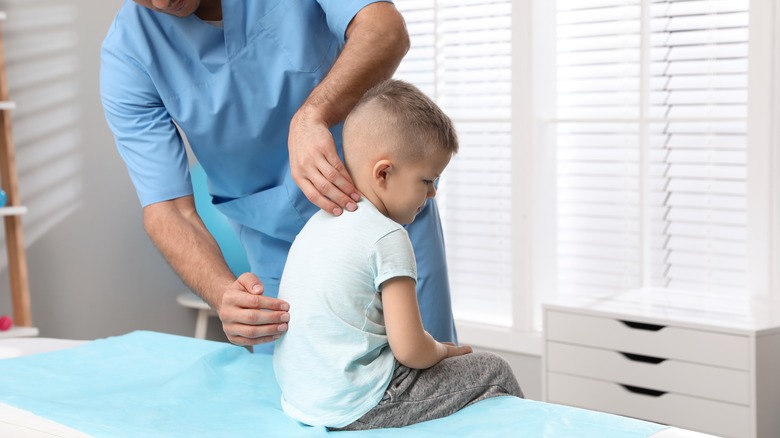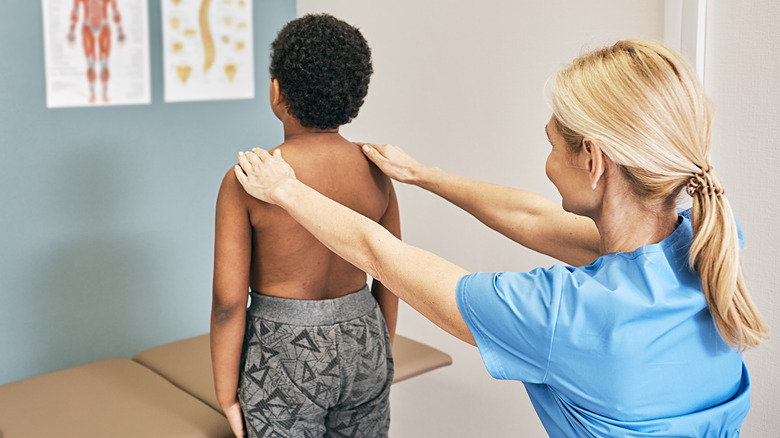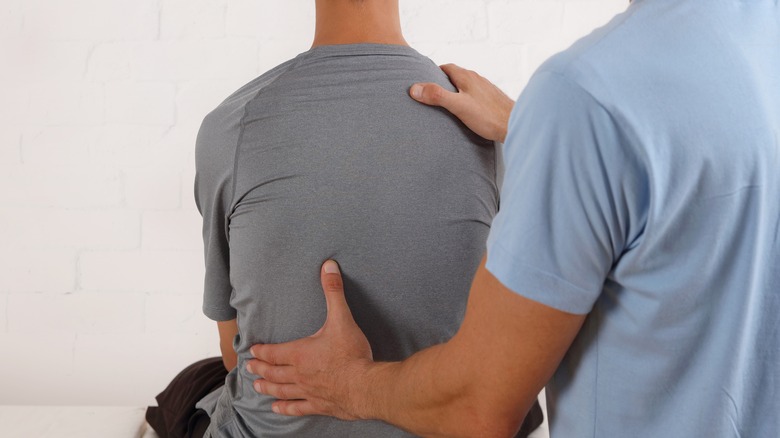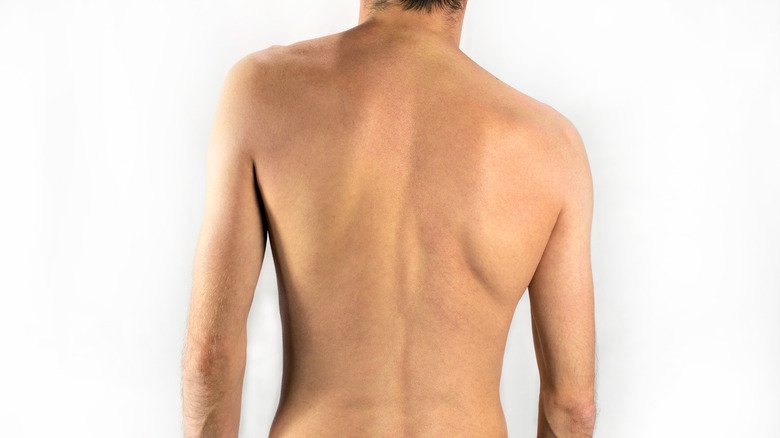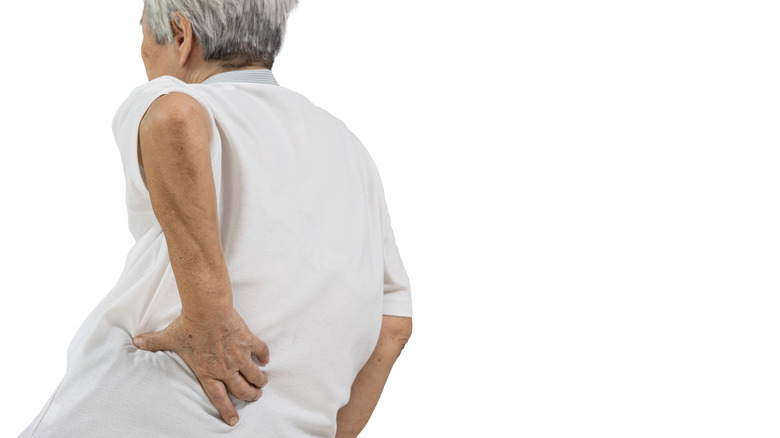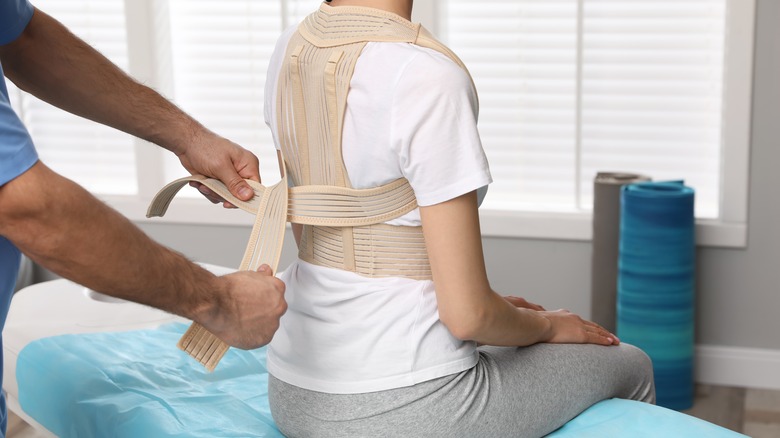The Types Of Scoliosis Explained
The spine is a part of the body that you probably won't think about until something goes wrong with it. But many people suffer from abnormally curved spine conditions, including flat back syndrome, kyphosis (round-back), lordosis (swayback), and scoliosis (via Medicine Net). With scoliosis, the spine curves to the left or the right side of the body, according to the American Association of Neurological Surgeons (AANS). About seven million Americans have scoliosis, and the condition typically manifests during adolescence (via National Scoliosis Foundation).
The symptoms of scoliosis include a curved back; leaning to one side; uneven shoulders, ribs, waist, hips or legs; back pain; or leg numbness. Nemours Kids Health adds that scoliosis might not be obvious and is sometimes only found during a screening. Scoliosis diagnosis involves a physical exam, a spinal X-Ray, a CT (computed tomography) scan, or an MRI (magnetic resonance imaging), per the AANS. Once you're diagnosed, your doctor will classify your scoliosis based on its type, your age, the size of the curve, and the location of the curve. Knowing the type of scoliosis you have will guide the management of your condition by your providers (via Scoliosis Reduction Center).
Basic anatomy of the spine
Your spine supports your body's posture and movements. It also protects your spinal cord, the communication pathway that allows the brain to control the body (via University of Maryland Medical Center). The spine is made up of bones known as vertebrae. Intervertebral disks cushion these vertebrae, and facet joints between each vertebrae enable motion of the spine. The spinal cord is housed in a tunnel formed by the stacked vertebrae, known as the spinal canal, and nerves branch out through tiny openings within the vertebrae (via Cleveland Clinic).
The spine has five regions: the cervical spine (within the neck), the thoracic spine (the mid-back), the lumbar spine (the lower back), and the sacrum and coccyx within the hips. When viewed from one side, the spine has a gentle S curve (via Spine Universe). When the spine is viewed from the front or back, it appears straight. For people with scoliosis, the spine curves to one side (via MedlinePlus). But it's not just as simple as that. The curved spine rotates as the condition worsens. The outer part of the curve twists backward while the inner part twists forward. Any ribs attached to these parts twist too. Also, the inner part of the curve and connected ribs squeeze together while the outer part and connected ribs fan out. This makes scoliosis a complex condition (via University of Washington Medicine).
Location of scoliosis curve
Scoliosis can be categorized by where it's located. It may form at any part of the upper three regions of the spine, though scoliosis of the cervical spine (in the neck) is rare and causes more pain than scoliosis in other regions (via Scoliosis SOS Clinic). Thoracic scoliosis, which develops within the mid-back, is the most common form of scoliosis (via Scoliosis Reduction Center). It is easily noticeable, as it makes the shoulders uneven and causes a rib hump by bending and rotating the ribs. Lumbar scoliosis is less noticeable and develops in the lower back. It is also more often seen among adults older than 65 and is caused by degeneration of the spine (via Southwest Scoliosis and Spine Institute).
The curvature of the spine could span more than one region. This would form a combined scoliosis. An example of this is thoracolumbar scoliosis, which spans the lower thoracic and upper lumbar regions of the spine (via Clear Scoliosis Institute). Another place a combined scoliosis can form is between the cervical and upper thoracic spine. This is called a cervicothoracic scoliosis, but it's uncommon (via Scoliosis SOS Clinic).
Curvatures of scoliosis
The direction of the curves made by scoliosis can be used to describe your condition. If your spine curves to your left, it's known as levoscoliosis. If it curves to your right, It's known as dextroscoliosis (via Cleveland Clinic). Levoconvex scoliosis and dextroconvex scoliosis are also terms used to describe the curves of scoliosis. Scoliosis SOS Clinic explains that these are more specific ways to refer to levoscoliosis and dextroscoliosis, respectively. Every curve has a convex (outer) and concave (inner) part. These terms make it clear that it's the outer part of the spine that curves to the left or right.
The Scoliosis Reduction Center notes that although the spine can curve at any region, dextroscoliosis of the thoracic spine is the most common type of scoliosis. On the other hand levoscoliosis is unusual and usually happens because of another condition. It can happen in any spine region, but it is mostly seen in the lumbar spine.
The shape of a curve can be used to distinguish different scoliosis cases. Levoscoliosis takes on a C shape, while dextroscoliosis has a reverse C shape (per Scoliosis SOS). Some people have two (double major) curves, one in the thoracic region and the other in the lumbar region. If these curves oppose each other, they form an S-shape. This form of scoliosis can be difficult to identify, as both curves could balance each other.
Scoliosis severity
Scoliosis is diagnosed when the spine has more than a 10-degree curve to one side. The spine's curvature is popularly assessed using the Cobb angle measurement (via Scoliosis 3DC). The vertebrae at the top and bottom of the curve are used for this measurement because they are the most slanted. Parallel lines are drawn from these two vertebrae. Next, perpendicular lines are drawn from the parallel lines. The angle formed where the perpendicular lines meet is the Cobb angle.
Scoliosis is classified as mild, moderate, or severe based on the Cobb angle. Mild scoliosis has an angle between 10 and 25 degrees. Moderate scoliosis measures between 25 and 40 degrees, and severe scoliosis, above 40 degrees (via Clear Scoliosis Institute). Most mild cases of scoliosis go unnoticed, because they are neither painful nor as visually apparent. The condition's symptoms become more conspicuous in the moderate to severe stages (via Scoliosis Reduction Center).
The curvature of scoliosis may worsen over time, and this is known as progressive scoliosis. Scoliosis 3DC describes scoliosis as progressive when its Cobb angle grows by 5 degrees or more in a six-month period. Scoliosis cases with larger Cobb angles have a higher risk of being progressive. Mild scoliosis has about a 20% chance of being progressive, though this risk elevates as the Cobb angle increases (via Southwest Scoliosis and Spine Institute).
Structural versus non-structural scoliosis
Scoliosis can be structural or non-structural depending on whether the spine's structure is altered. Structural scoliosis includes all forms of scoliosis where there is an actual curve of the spine (via Scoliosis SOS). The curved spine also rotates to some extent as it twists and bends. This makes structural scoliosis a three-dimensional condition. If this rotation is severe, it is termed rotoscoliosis (via Scoliosis Reduction Center).
For non-structural or functional scoliosis, the spine looks curved, but this is a result of another problem, says Scoliosis SOS. Non-structural scoliosis may be because of a bad posture or muscle imbalance. It could be the body compensating for another problem such as different leg lengths or an uneven hip. It may also be transient if it's a response to pain. A simple way experts differentiate structural from non-structural scoliosis is by asking you to lie down or bend at your hips. If scoliosis goes away in this position, it's most likely non-structural (via Clear Scoliosis Institute).
Neuromuscular scoliosis
According to the Scoliosis Research Society (SRS), neuromuscular scoliosis is caused when a person's muscles and nerves are incapable of keeping the spine straight. Typically the underlying cause is a brain, spinal cord, or muscular condition. Disorders that can cause neuromuscular scoliosis include cerebral palsy, myelodysplasia, spinal muscle atrophy, Friedreich ataxia, Duchenne muscular dystrophy, and traumatic paralysis. Not all children with neuromuscular conditions will develop neuromuscular scoliosis, says OrthoInfo. It is, however, more likely to affect children who use wheelchairs.
A 2019 review published in Current Reviews in Musculoskeletal Medicine notes that although neuromuscular scoliosis is caused by different conditions, it presents in a similar fashion. It often impacts one's ability to stand or walk, as well as seated posture, especially in people using wheelchairs. Over time, the condition causes pain, skin ulcerations, and heart and lung problems. Supportive braces or custom-made seats are non-surgical options to assist those with neuromuscular scoliosis, but unfortunately these can have limited efficacy or be very expensive. Surgical options such as spinal fusion might be undertaken to stabilize the patient's spine and pelvis, and the review authors note that while these procedures are prone to complications, the benefits may outweigh the risks.
Congenital scoliosis
Congenital scoliosis is an unusual birth defect that happens when either a vertebra does not form completely, or when adjacent vertebrae fail to separate into individual bones, but instead remain fused (via AAOS). Children with this condition might look as if they are tilted, and their ribs, waist, hips, and shoulders may all be noticeably uneven. It's also possible that congenital scoliosis will manifest as lordosis (sway back) or kyphosis (round back), according to SRS.
Congenital scoliosis usually starts forming during the first six weeks of pregnancy when the baby's spine begins to develop. It's uncertain what initiates this altered development, but congenital scoliosis is associated with other birth defects, according to an article published in the Journal of Medicine and Life. These defects can be caused by exposure to carbon monoxide, a mother's use of antiepileptics, gestational diabetes, when the developing baby is deprived of oxygen, or when the mother has a prolonged fever or is exposed to very high temperatures. It's difficult to tell if and how badly congenital scoliosis will progress. So, this condition needs to be monitored, especially within the first five years of life and during adolescence, periods that are associated with rapid growth (via SRS).
Early onset scoliosis
Early onset scoliosis refers to scoliosis found in children under age 10 (via SRS). It could be a neuromuscular or congenital scoliosis. It could also be caused by certain syndromes that affect children and may cause scoliosis, such as Marfan's, Ehlers-Danlos, and Prader-Willi syndromes, as well as neurofibromatosis and bone dysplasia. Early onset scoliosis may be idiopathic, which means it has no cause. Idiopathic scoliosis found in children younger than 3 is known as infantile idiopathic scoliosis. In children aged 4 to 10, it is known as juvenile idiopathic scoliosis.
Whether early onset scoliosis will progress and how it will progress depends on the nature, type, and possible cause of scoliosis as well as the age of the child. Early onset scoliosis may lead to lung and heart problems if it forms in the thoracic region (via Infantile and Juvenile Scoliosis). These structures actively develop during childhood, and scoliosis may hinder their proper development. One condition that can result is thoracic insufficiency syndrome, in which the lungs fail to function properly because of the abnormal growth of the lungs and ribs.
Adolescent idiopathic scoliosis
Adolescent idiopathic scoliosis develops during the adolescent growth spurt and usually causes no symptoms in any other part of the body (via MedlinePlus). According to a study published in the Journal of Children's Orthopaedics, most cases (about 90%) of idiopathic scoliosis in children develop in adolescents. This form of scoliosis is not only more common among females, but females are also more prone to having severe or progressive forms.
Although the condition is seen as having no cause, researchers are looking for the possible causes and the risks of progression of the condition, says SRS. Adolescent idiopathic scoliosis has been linked with hormonal imbalance, muscle imbalance, asymmetric growth, and genetics, as 30% of people with this condition have a family member with scoliosis.
According to an article from American Family Physician, though many people with this form of scoliosis don't show any symptoms, some with severe or progressive curves may experience pain, respiratory problems, and cosmetic deformity. This is associated with psychosocial distress, increased expenses, and a reduced quality of life.
Adult idiopathic scoliosis
Scoliosis is often seen as a condition that affects children and teens, but it can also impact adults. Adult scoliosis can be idiopathic, caused by degeneration of the spine, caused by trauma that compromises the integrity and strength of the spine, or a combination of these conditions (via Premia Spine). Adult idiopathic scoliosis is the most common type of adult scoliosis, affecting nearly 10% percent of adults aged 25 to 75, according to the Atlanta Spine Institute. They note that the risk of developing scoliosis is greater as we age, and that existing scoliosis is also likely to worsen as one gets older, as the spine degrades.
People with adult idiopathic scoliosis experience additional symptoms like shooting pain down the legs (sciatica), leg cramps or numbness, a stiff or uncomfortable lower back, and general fatigue. These symptoms may be caused by formation of bone spurs due to arthritis, degeneration of the spinal discs, or narrowing of the vertebral openings and spinal canal (spinal stenosis), according to the SRS.
Degenerative scoliosis
Degenerative scoliosis is also known as adult new onset scoliosis because it forms in adults, usually above 50, who haven't had scoliosis before (via Spine Health). This type of scoliosis is caused by the degenerative changes to the intervertebral discs and facet joints when a person gets older. The spine curves when degeneration is more prominent on one side of the spine than the other. Degenerative scoliosis is more common in the lumbar spine (via SRS).
Pain is a common symptom of degenerative scoliosis. The Hospital for Special Surgery explains that pain in the back — which can also travel to the hips, buttocks, and legs — is caused by degeneration of the spine or muscle spasms. Degenerative scoliosis can also contribute to spinal stenosis, a compression of nerves in the spinal cord, which can lead to numbness, weakness, or pain in the legs. According to the Cleveland Clinic, treatment of adult scoliosis is geared toward relieving the symptoms of the degeneration and improving function rather than correcting the curve. Spine surgery has a high risk of complication in older adults, so surgical treatment is typically a last resort undertaken only when there is an unbearable impact on the quality of life.
Treatment for scoliosis
Once you are diagnosed with scoliosis, its treatment will depend on the type of scoliosis you have, your age, how severe scoliosis is, if you have other conditions, and the symptoms you experience. Most mild cases of scoliosis are benign and may only require observation by your doctor (via WebMD).
Infants with scoliosis may require a cast to slow down the progression of the condition (via Pediatric Scoliosis Surgery). Children and adolescents may need to wear scoliosis braces to prevent the curves from worsening as they grow. Braces can be rigid or dynamic, and may need to be worn full-time or only at night (via Healthline).
If braces don't work or aren't practical, surgery may be required to treat scoliosis. Surgery is aimed at preventing the worsening of curves, correcting the curve and rotation of the spine, and balancing the trunk, spine, and hips while ensuring that the spinal cord isn't affected (via Spine Health). Surgery may involve fusing some vertebrae to prevent a curved growth, placing rods in the spine to correct curves, or by novel fusionless techniques. Other non-surgical approaches to scoliosis treatment include specific exercises, physical therapy, yoga, acupuncture, and functional electrical stimulation, according to a review published in the Journal of Craniovertebral Junction & Spine. These treatments are usually combined with other interventions for better results.

